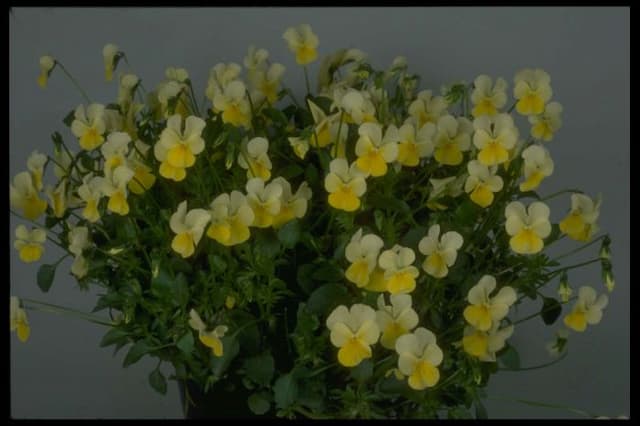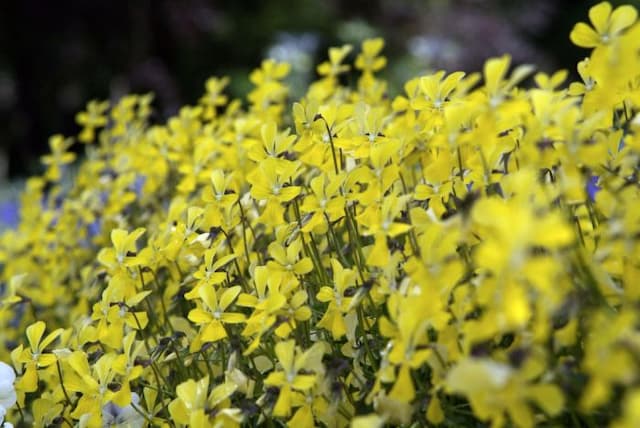Pansy Viola 'Duchesse de Parme' (dPVt)

ABOUT
Viola 'Duchesse de Parme' is a type of pansy known for its striking flowers. The blooms have a distinctive color pattern, with deep purple to maroon upper petals, which are sometimes referred to as "whiskers" due to their velvety texture and bold lines. The lower petals range from a soft yellow to a creamy hue, creating a beautiful contrast against the darker tones above. This transition of color is eye-catching and often has a gradient or ombre effect, blending the purple down into the lighter shades. The petals are rounded with a slight ruffling at the edges, giving the flower an elegant, frilly appearance that adds to its overall charm. The face of the flower typically features a central dark blotch or splotch that serves to highlight the bright yellow center, where the reproductive parts of the flower are found. The foliage of the plant is lush and green, with leaves that are heart-shaped or ovate and often have a slight sheen. The leaves are arranged in a basal rosette, emerging from the base of the plant and creating a backdrop that showcases the colorful flowers. The texture of the leaves is typically somewhat glossy, with a slightly wavy or crinkled edge, adding depth and interest to the plant's appearance. Overall, Viola 'Duchesse de Parme' is a captivating plant with vibrant, showy flowers that are sure to draw attention in any garden setting. Its petite blossoms provide an ornamental quality that is beloved by gardeners and flower enthusiasts alike.
About this plant
 Names
NamesFamily
Violaceae.
Synonyms
Duchess of Parma Violet, Pansy Duchess of Parma.
Common names
Viola 'Duchesse de Parme'
 Toxicity
ToxicityTo humans
Viola 'Duchesse de Parme' is commonly known as Pansy. Pansies are generally considered non-toxic to humans. However, as with any plant, some individuals may have allergic reactions or sensitivities. Ingesting large quantities of any plant material may cause gastrointestinal upset due to the presence of saponins and other compounds. If very large amounts are eaten, symptoms may include nausea, vomiting, and diarrhea. Nonetheless, occasional small amounts, such as a few petals used as a garnish, are typically safe for most individuals.
To pets
Pansy, the most common name for Viola 'Duchesse de Parme', is not known to be toxic to pets. However, ingestion of plant parts, especially in large quantities, can cause mild gastrointestinal upset in some animals, which may manifest as vomiting or diarrhea. It's always best to keep an eye on your pet if they have a tendency to nibble on plants and to consult with a veterinarian if you observe any unusual symptoms after ingestion.
 Characteristics
CharacteristicsLife cycle
Perennials
Foliage type
Deciduous
Color of leaves
Green
Flower color
Mixed
Height
6 inches (15 cm)
Spread
6 inches (15 cm)
Plant type
Herb
Hardiness zones
4
Native area
Europe
Benefits
 General Benefits
General Benefits- Aesthetic Appeal: Viola 'Duchesse de Parme' boasts colorful flowers that add visual interest to gardens and landscapes.
- Pollinator Attraction: The blooms attract beneficial pollinators like bees and butterflies to the garden, which is essential for the pollination of many other plants.
- Seasonal Interest: They have an extended blooming period from spring into late fall, providing color for multiple seasons.
- Compact Growth: This viola variety has a compact growth habit, making it suitable for borders, containers, and small garden spaces.
- Easy Care: It is relatively easy to grow and maintain, requiring minimal care once established.
- Versatility: The plant can be used in various garden designs, including rock gardens, container plantings, and as bedding plants.
- Cold Tolerance: They can tolerate cold temperatures and are often able to withstand frost, making them suitable for cooler climates.
- Edible Flowers: The flowers are edible and can be used to garnish salads, desserts, and drinks, adding a splash of color and slightly sweet flavor.
 Medical Properties
Medical PropertiesThis plant is not used for medical purposes.
 Air-purifying Qualities
Air-purifying QualitiesThis plant is not specifically known for air purifying qualities.
 Other Uses
Other Uses- Edible Decorations: The colorful flowers of the pansy 'Duchesse de Parme' can be candied and used to decorate cakes, desserts, and other pastries, giving an elegant and vibrant touch.
- Fabric Dye: The vibrant petals can be used to create natural dyes for fabrics, imbuing them with shades of purple and blue.
- Culinary Flavoring: Fresh or dried pansy petals can be used to impart a mild wintergreen flavor to syrups, beverages, or homemade jellies.
- Plant Dye for Cosmetics: The petals can be infused into oils or distilled water to create natural colorants for homemade cosmetics like lip balms and blushes.
- Ice Cubes: Freeze pansy flowers inside ice cubes to add a pop of color and a hint of flavor to punch bowls or cocktails.
- Nature Crafts: Pressed pansy flowers can be used to create bookmarks, greeting cards, or framed botanical art.
- Salad Garnishes: The fresh flowers can be tossed into green salads for a splash of color and a subtle, grassy flavor.
- Aromatic Potpourri: Dried pansy flowers can be included in potpourri mixes to add a light, pleasant fragrance to your home.
- Signature Cocktails: Infuse clear spirits with pansy petals to create a uniquely flavored and visually appealing signature cocktail.
- Botanical Sachets: Fill sachets with dried pansy flowers and place them in drawers or closets for a sweet, natural scent.
Interesting Facts
 Feng Shui
Feng ShuiThe pansy is not used in Feng Shui practice.
 Zodiac Sign Compitability
Zodiac Sign CompitabilityThe pansy is not used in astrology practice.
 Plant Symbolism
Plant Symbolism- Modesty: The violet, generally, is often associated with humility and modesty owing to its small and unassuming flowers that nestle close to the ground.
- Innocence: As violets typically bloom early in the spring, they are also connected to the idea of innocence and purity.
- Faithfulness: The enduring quality of the violet, which can often be one of the first flowers to emerge from the cold ground, symbolizes loyalty and steadfastness.
- Spiritual Wisdom: Purple hues, commonly found in violas, are associated with spiritual insight and enlightenment.
- Love: Some traditions hold that giving a violet to a loved one expresses a deep, abiding affection.
 Water
WaterPansies, including the Viola 'Duchesse de Parme', prefer consistently moist soil, so it's key to water them regularly. They should be watered gently at the base to avoid wetting the foliage, which can lead to fungal diseases. During the active growing season, typically in spring and fall, watering may be necessary once every week, but always check the top inch of soil for dryness before watering. During hot spells or in particularly dry climates, you may need to water more frequently. As a guideline, each plant should receive about one gallon of water per week, but this can vary based on rainfall and temperature conditions.
 Light
LightPansies including the Viola 'Duchesse de Parme', thrive best in full sun to partial shade. They should be positioned in a spot where they receive at least six hours of sunlight each day. However, in regions with very hot summers, providing some afternoon shade will help preserve their vibrant colors and prevent them from wilting.
 Temperature
TemperatureThe ideal temperature conditions for pansies, such as the Viola 'Duchesse de Parme', range from 40 to 60 degrees Fahrenheit. They can survive in temperatures as low as 20 degrees and as high as 80 degrees Fahrenheit, which makes them a hardy choice for cool to temperate weather gardening. For robust growth and flowering, it is best to maintain the ideal temperature range as much as possible.
 Pruning
PruningPansies such as Viola 'Duchesse de Parme' should be deadheaded regularly to encourage more blooms and maintain their appearance. Pinch off spent flowers and any damaged or yellowing leaves to promote new growth. The best time to prune pansies is in the early morning or late evening to prevent stressing the plant during the heat of the day. Pruning can be done as needed throughout the blooming season.
 Cleaning
CleaningAs needed
 Soil
SoilPansy 'Duchesse de Parme' thrives in moist, well-draining soil with a slightly acidic to neutral pH of 6.0 to 7.0. A mix of peat, compost, and perlite or vermiculite is ideal to provide the necessary nutrients and drainage.
 Repotting
RepottingPansies, like 'Duchesse de Parme', generally do not require frequent repotting and can be repotted every 1-2 years or as needed when they outgrow their current container.
 Humidity & Misting
Humidity & MistingPansy 'Duchesse de Parme' prefers moderate humidity levels but is adaptable to the average humidity found outdoors and does not require specific humidity adjustments.
 Suitable locations
Suitable locationsIndoor
Place in bright, indirect light and ensure good air circulation.
Outdoor
Plant in partial sun with well-draining soil.
Hardiness zone
6-9 USDA
 Life cycle
Life cycleThe Viola 'Duchesse de Parme', commonly referred to as pansy, begins its life cycle when seeds are sown into well-drained soil, ideally during late winter for early spring flowering or during summer for overwintering plants. Germination of the pansy seeds generally occurs within one to two weeks, and seedlings will emerge and grow into young plants with characteristic heart-shaped leaves. As the pansy seedlings mature, they develop into compact, bushy plants that produce flowers in a range of colors, typically with overlapping rounded petals that often display face-like center markings. Flowering occurs during cooler seasons, such as spring and fall, and pansies can even bloom during winter in mild climates. After blooming, if flowers are left to mature, they will set seed that can be collected for future propagation. With proper care, pansies are biennial, meaning they will complete their life cycle over two growing seasons, but are commonly treated as annuals and replaced each year for best display.
 Propogation
PropogationPropogation time
Spring to early summer
The Viola 'Duchesse de Parme', commonly known as pansy, is often propagated in late winter to early spring, capitalizing on the ideal growing conditions as the climate transitions from cold to warmer temperatures. The most popular method of propagation for pansies is through seed, as they readily germinate and can be sown indoors around 8 to 12 weeks before the last frost date. Seeds should be scattered onto moist, well-drained soil and gently pressed in, but not covered, as pansy seeds require light to germinate. To maintain optimal germination conditions, the soil should be kept consistently moist and at a temperature around 65 to 75 degrees Fahrenheit (18 to 24 degrees Celsius). Seedlings typically emerge in 10 to 14 days and can be transplanted to their final growing location once the risk of frost has passed and they've developed a strong root system.









